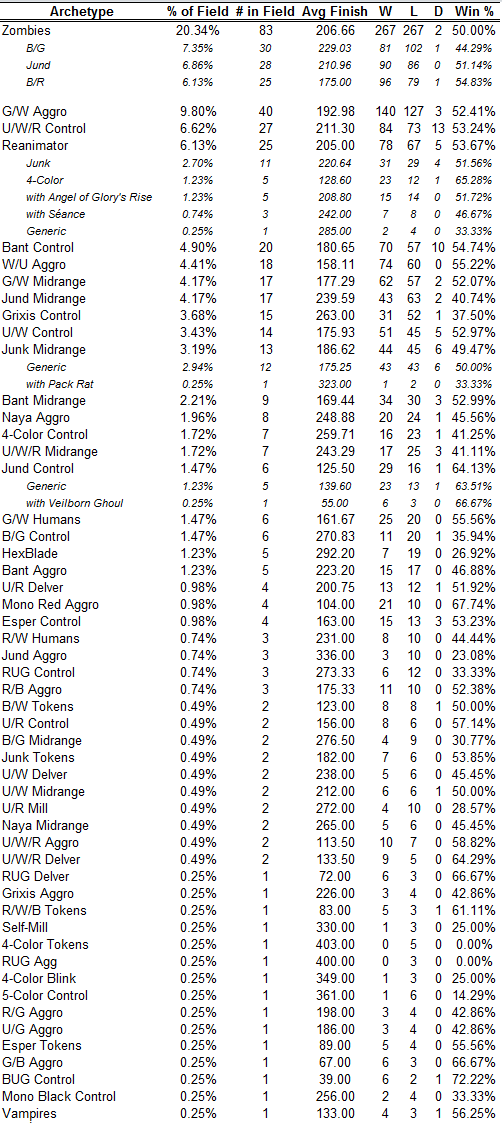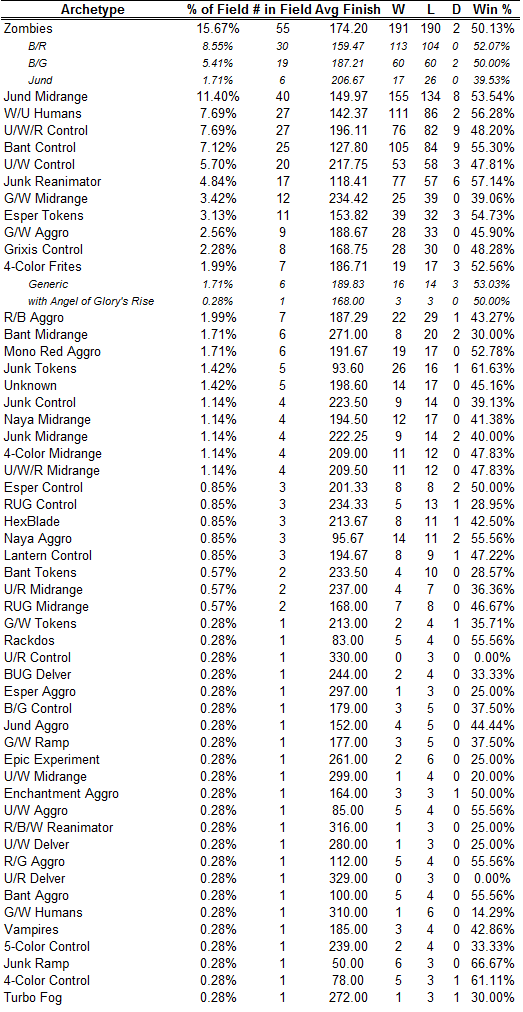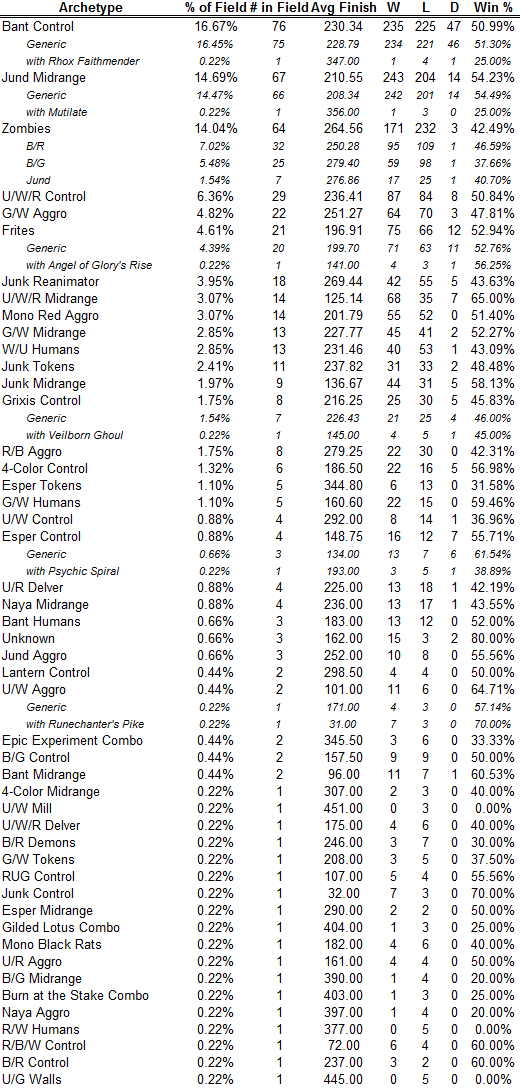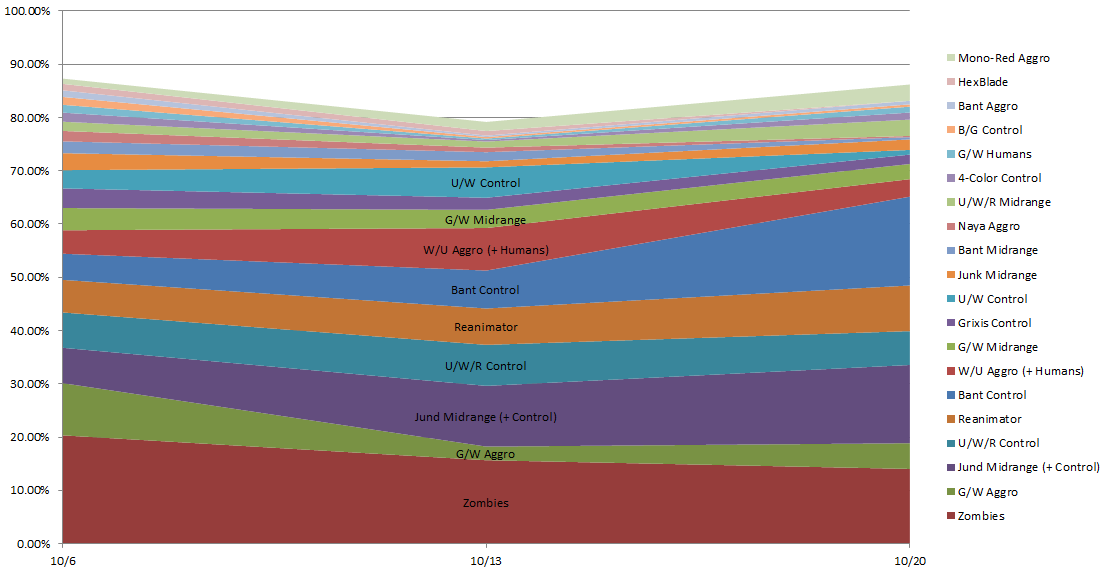Welcome to Too Much Information, the official statistics article of the StarCityGames.com Open Series! My name is John Armstrong, and I’ve been offered the opportunity to present you with a veritable cornucopia of data from the StarCityGames.com Standard Opens since the release of Return to Ravnica. Let’s dive right in!
Cincinnati Standard Open ÃҢââ⒬šÒ¬Ã¢â‚¬Å” October 6
We haven’t visited the statistics area of metagame analysis on StarCityGames.com recently, so we have a lot of catch-up work to do! The first stop for us is SCG Open Series: Cincinnati, way back on the first weekend in October, the first Standard Open for which Return to Ravnicawas legal. If you can remember, Zombies were being hyped as the top dog before the tournament began. Let’s go to the data to see how this panned out.
ÂÒÂ
ÂÒÂ
As we can see, many players bought into the Zombie plan, with Zombies of different color combinations taking up over 20% of the 408-player field. However, the brain-eaters didn’t put up the overwhelming amount of wins they were expected to, posting an average finish of just below the midpoint. Three Zombies pilots made it to the Top 8 of the eventÃҢââ⒬šÒ¬Ã¢â‚¬ï¿½one each of the Golgari, Rakdos, and Jund builds.
The victor of this tournament was Todd Anderson, piloting the U/W/R Control list that would become a format mainstay for the rest of the month. Featuring a large anti-aggro package in anticipation of the Zombie swarm, Todd and the other 26 U/W/R players posted an overall win percentage of over 53%. The deck seemed to have very strong matchups against most of the other top decks at the tournament, especially those that leaned towards the aggressive side of the spectrum.
ÂÒÂ
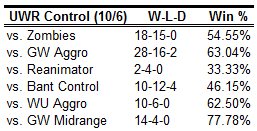
ÂÒÂ
However, these were certainly not the only two decks to make strong appearances at the tournament. Also making appearances in the Top 8 were one copy each of Reanimator and G/W Aggro and two Jund Midrange decks.
Overall, the metagame for the first Standard Open of the season was extremely diverse. Excited by the new set’s release and the rotation of Scars of Mirrodin, the competitors in Cincinnati showed up with decks from over 50 distinct archetypes. Zombies did not completely dominate the event as many expected, but it did certainly solidify its position as a “Level One” for testing future lists. Players were now certain that they were going to need to have a plan against the Zombie horde for the upcoming Standard Open events.
Providence Standard Open ÃҢââ⒬šÒ¬Ã¢â‚¬Å” October 13
One weekend later, the SCG Open Series chugged eastward to Providence, Rhode Island. The metagame had been widened by the previous week’s diversity, and players were ready to try new approaches. Here’s the metagame at a glance for that week.
ÂÒÂ
ÂÒÂ
Zombies carried on its reign as the most popular deck, and its pilots carried on their approximately even win percentages. A lone Zombies player persevered into the Top 8, with two more copies falling between 9th and 16th. The black/red version of Zombies was both the most played and most successful variation of the deck.
The top story of the Standard Open in Providence, however, was the emergence of the Jund Midrange decks. Fusing together elements of aggro, control, and midrange decks, Jund Midrange placed two players into the Top 8 after being relatively unpopular just a week earlier. With a certainly passable win rate of over 53%, Jund players overpowered their opponents to become the second-most popular archetype, due largely in part to its impressive matchups against the rest of the top contenders.
ÂÒÂ
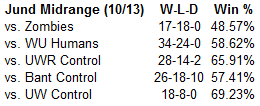
ÂÒÂ
Also increasing in popularity this week was U/W Humans, boasting an impressive 56% win rate. This aggressive strategy uses first strike and protection from black creatures to fend off Zombies as well as resilient threats like Geist of Saint Traft to attack the control decks, breaking up the dominance of Zombies as THE aggro deck of the format. Attacking from this different angle led one Humans player to the Top 8.
As the metagame shifts, archetypes are created, destroyed, and merged. Examining these changes can help to gain an overall view of where the metagame is headed. For example, let’s take a look at this chart showing the shift in field share of the major archetypes (>1% field) from the Standard Open in Cincy.
ÂÒÂ
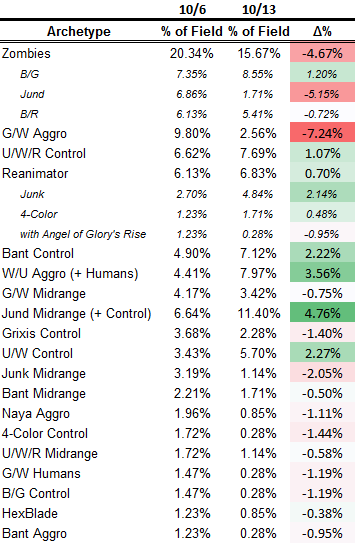
ÂÒÂ
Many of the fringe strategies that were played in Cincinnati were merged into larger archetypes. This could explain the large increase in the play of decks like Jund Midrange and W/U Humans. Simultaneously, weaker strategies were passed over in favor of more solidified options.
Indianapolis Standard Open ÃҢââ⒬šÒ¬Ã¢â‚¬Å” October 20
With the Standard Open in Providence finished and the 2012 State and Provincial Championships done with, one would think that the metagame would start to settle into place on the weekend of SCG Open Series: Indianapolis. To an extent, this was true. Again, let’s go to the data.
ÂÒÂ
ÂÒÂ
For the first time in the season, three decks more-or-less shared the spotlight at the top. The most played deck was Bant Control. Coming off its increase in popularity and success in Providence, many people adopted the Bant plan to combat the rise of Jund and the ever-prevalent Zombies. Bant failed to place a player into the Top 8, but moderate success was widespread, with the archetype finishing with a win rate just shy of 51%.
Jund continued its strong run, making up 14.69% of the field and with a win rate over 54%. Three Jund players placed in the Top 8 spots, with one making it all the way to the finals. The deck’s high power level and versatility kept it strong against a field full of changes.
Numbers for Zombies dwindled further, with the black-focused aggro archetype barely making up 14% of the field and posting a dismal 42.5% win rate. The power of Thragtusk and other anti-aggro elements in the top decks proved too much for Zombies to handle this week.
ÂÒÂ
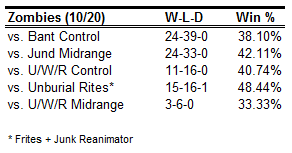
ÂÒÂ
The winner of this tournament was Rob Vaca playing Four-Color Reanimator, or Frites as it is classified in our charts. Four-Color Reanimator had a great day at this tournament, putting two players into the Top 4 while making up only 4.61% of the field. The four-color variant of the Unburial Rites themed decks seems to be rising to the top, with a match win advantage over the Junk version by almost ten percentage points.
The surprise deck from this tournament, however, was not based on the graveyard at all. Chase Lamm and Todd Anderson both reached the Top 8 playing U/W/R Midrange decks featuring Restoration Angel, Geist of Saint Traft, and Thundermaw Hellkite. This deck tore through the field, giving its fourteen pilots an astonishing win percentage of 65%.
ÂÒÂ
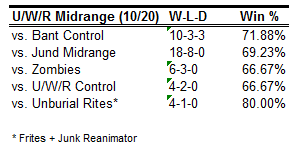
ÂÒÂ
Other so-called “tier 2” decks continued to field many players, including G/W Aggro, Mono-Red Aggro, G/W Midrange, U/W Humans (which had a particularly poor win rate), and the previous week’s winner, Junk Tokens.
Observing Patterns
So with three weeks of data available to us, what sort of conclusions can we draw about the future? Let’s take a look at field percentages over time for the major archetypes. (Note: some early archetypes have been merged to show that their plans are similar and would eventually evolve into the same macro-archetype)
ÂÒÂ

ÂÒÂ
In this chart, ÃҢËâ⒬ Ã¢â‚¬Ò % represents the change in percentage points for an archetype over the three weeks we’ve covered. This does not mean that the percentage of Bant Control players has increased by 11.77% (multiplicatively). It means that your probability of playing against Bant Control in any given round has increased additively by 11.77% (from 4.9% to 16.67%).
Looking at the data this way, we can see that a few archetypes that were initially underplayed have come to be recognized as the formats heavy hitters. Likewise, a few of the early heavy hitters like Zombies have fallen greatly out of favor. Here’s this chart in a graphical form, which will carry a lot more meaning as we progress further into this Standard environment’s development.
ÂÒÂ
ÂÒÂ
This graph shows each large archetype’s field percentage over time, with the oldest on the left and proceeding forward from there. The total area occupied by the graph at each point shows the amount of the total field that this “metagame” accounts for, or oppositely, it shows how much of the field is comprised of “rogue” or “fringe” decks.
Again, with relatively little information it is difficult to draw conclusions from these types of graphs, but as time goes on we will possibly be able to use them to predict trends or watch the evolution of a late-season breakout deck.
The Thragtusk Question
To finish off this article, I want to do sort of a fun little experiment. A lot of people in the Magic community have been saying that Thragtusk is too ubiquitous, or it’s bad for Magic, or it’s causing global warming, or whatever. Well, why don’t we use the statistics available to us to see how big of a problem Thragtusk really is?
Past writers of Too Much Information have approached such a question (say, with Jace, the Mind Sculptor) with the following method. Let’s take the three most popular Thragtusk decks as of the Standard Open in Indy (Bant Control, Jund Midrange, G/W Aggro) and the three most popular non-Thragtusk decks (Zombies, U/W/R Control, U/W/R Midrange) and compare their win percentages over the three events for which we have data.
ÂÒÂ
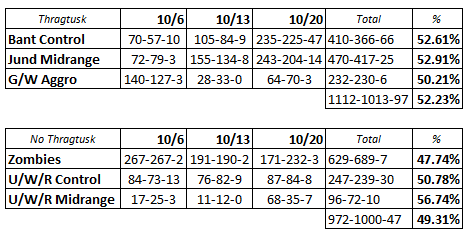
ÂÒÂ
I’ll admit this isn’t enough data to really draw a definite conclusion, but we can see a few interesting things:
- U/W/R Midrange is criminally underplayed with respect to its win percentage.
- Zombies is likewise criminally OVERplayed (however, this seems to be coming to a close, as we saw on our metagame shifts chart).
- Your midrange deck doesn’t need a Thragtusk to win the game!
- Despite this, people love to play Thragtusk decks.
Is Thragtusk a powerful card? Yes. But as of yet, the numbers aren’t there to suggest that it’s TOO powerful.
What have we learned? There’s a lot still open to interpretation here, especially considering the fact that we only have three weeks of data so far! As of this writing, I do not yet have the data for the New Orleans Open, and the St. Louis Open is in about 36 hours. Each of these events represents a potential for the metagame to swing in a big way. Many different types of decks had a strong showing in New Orleans, including the winner Brad LeBoeuf’s G/W Humans deck, an archetype that we had not heard much from previously. All the format’s big players were there, with Zombies yet again missing the Top 16 range. Although Humans took home the trophy, there were ten(!) “midrange” decks in the Top 16.
The format hasn’t settled down yet, that’s for certain. There is no consensus “best deck.” The environment is healthy and balanced, and that’s the type of environment where playing the percentages and figuring out patterns can really get you a leg up on the competition.
I hope you’ve enjoyed this brief walk through the past few weeks of Standard decks. Hopefully, you can go on to use what you’ve read here to better inform yourself and your deck decision for the next SCG Open Series in your area!
If you have any questions about what you’ve read, suggestions for what you’d like to see in the next article, or complaints that I can improve on for next time, please let me know in the comments section or on Twitter (@CarefulStudy).
Thanks for reading!
Ã’Â
ÂÒÂ

